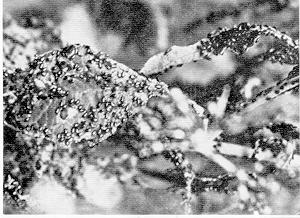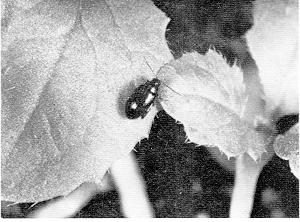| | Damage | Life history and description | Control
Adult flea beetles, Psylliodes punctulata melsheimer, can feed on sugar beet plants soon after seedling emergence in the spring. Feeding damage can lead to reduced plant growth, and even death, depending upon the density of beetles present and the growth stage of the sugar beet.
Damage
Plant injury is easily recognized by the appearance of round feeding holes on the leaves. These holes are formed when surface plant tissue is removed by chewing and the remaining tissue falls out, producing a characteristic "shot-hole" feeding injury. In some situations, when populations are high, the whole above ground portion of the sugar beet seedling may be consumed at the 2-leaf or cotyledon stage, thus killing the plant. Reduced plant growth and wilting of foliage during hot, dry weather are other problems that can occur as a result of flea beetle feeding.
Life History and Description
Flea beetles spend the winter as larvae in the soil or under crop debris left in the field. During late April and early May they form pupae and adults emerge. Adult beetles feed on leaves of various weed species and later migrate to feed on newly emerged sugar beet plants. The beetles are especially active when air temperatures are high, but will stop feeding and burrow back into the soil if the temperature drops.
The beetles lay their eggs in the soil close to host plants, including sugar beet seedlings in the spring. After hatching, larvae feed on plant roots and this may reduce plant growth in sugar beets. They complete feeding in 3 to 4 weeks and enter the pupal stage which gives rise to a second generation of adults. Each generation requires 5 to 10 weeks to mature from egg to adult. Damage to sugar beets is caused primarily by the spring generation when plants are in the seedling stage.
Adult flea beetles are small (2-4 mm), oval in shape, and shiny black. They have enlarged hind legs, which allow them to make sudden leaps when disturbed. They can often appear in swarms and are very active during warm, early summer days. The white colored eggs are 2 mm in length and are laid in the soil at a depth of 12 to 20 mm. The larvae are white, 3-4 mm in length at maturity and have dark brown heads. They form pupae which remain in the soil for up to two weeks, after which the adults emerge.

Figure 1. Severe flea beetle infestation. | 
Figure 2. Flea Beetle adult on sugarbeet leaf. |
Control
Control programs are usually only directed at the adult flea beetle stage early in the spring when sugar beet seedlings are small and most susceptible to defoliation. Damage to roots by larval feeding is minor and control is not generally economical. Later generations of adult beetles can cause some feeding damage but sugar beet plants are able to compensate for this injury through increased summer growth..
Cultural control methods include clean cultivation, so various weed species such as mustard or lamb's-quarters are not present to serve as alternate hosts. Foliar insecticides can also be applied to sugar beets for control of the adults in the spring. Adult beetles can migrate or be carried by the wind from one field to the next, so long-term control may require more than one application. In some cases, control of flea beetles is also achieved when granular insecticides have been used at planting for control of other sugar beet pests. When adult populations are low and growing conditions are good, no chemical control may be necessary.
Prepared by:
G. H. Whitfield and A.M. Harper, Agriculture Canada Research Station Lethbridge, AB
Source: Agdex 622-14. |
|